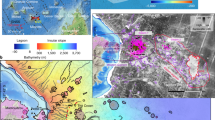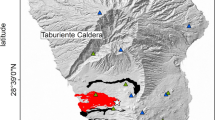Abstract
Hotspot tracks are thought to be the surface expressions of tectonic plates moving over upwelling mantle plumes, and are characterized by volcanic activity that is age progressive1. At present, most hotspot tracks are observed on oceanic or thin continental lithosphere. For old, thick continental lithosphere, such as the eastern United States, hotspot tracks are mainly inferred from sporadic diamondiferous kimberlites putatively sourced from the deep mantle2,3. Here we use seismic waveforms initiated by the 2011 Mw 5.6 Virginia earthquake, recorded by the seismic observation network USArray, to analyse the structure of the continental lithosphere in the eastern United States. We identify an unexpected linear seismic anomaly in the lower lithosphere that has both a reduced P-wave velocity and high attenuation, and which we interpret as a hotspot track. The anomaly extends eastwards, from Missouri to Virginia, cross-cutting the New Madrid rift system, and then bends northwards. It has no clear relationship with the surface geology, but crosses a 75-million-year-old kimberlite in Kentucky. We use geodynamical modelling to show that an upwelling thermal mantle plume that interacts with the base of continental lithosphere can produce the observed seismic anomaly. We suggest that the hotspot track could be responsible for late Mesozoic reactivation of the New Madrid rift system and seismicity of the eastern United States.
This is a preview of subscription content, access via your institution
Access options
Subscribe to this journal
Receive 12 print issues and online access
$259.00 per year
only $21.58 per issue
Buy this article
- Purchase on Springer Link
- Instant access to full article PDF
Prices may be subject to local taxes which are calculated during checkout



Similar content being viewed by others
References
Courtillot, V., Davaille, A., Besse, J. & Stock, J. Three distinct types of hotspots in the Earth’s mantle. Earth Planet. Sci. Lett. 205, 295–308 (2003).
Crough, S. T., Morgan, W. J. & Hargraves, R. B. Kimberlites: Their relation to mantle hotspots. Earth Planet. Sci. Lett. 50, 260–274 (1980).
Torsvik, T. H., Burke, K., Steinberger, B., Webb, S. J. & Ashwal, L. D. Diamonds sampled by plumes from the core-mantle boundary. Nature 466, 352–355 (2010).
Morgan, W. J. Hotspot tracks and the early rifting of the Atlantic. Tectonophysics 94, 123–139 (1983).
Wilson, J. T. A possible origin of the Hawaiian Islands. Can. J. Phys. 41, 863–870 (1963).
Smith, R. B. et al. Geodynamics of the Yellowstone hotspot and mantle plume: Seismic and GPS imaging, kinematics, and mantle flow. J. Volcanol. Geotherm. Res. 188, 26–56 (2009).
Sun, D., Helmberger, D. V. & Gurnis, M. A narrow, mid-mantle plume below southern Africa. Geophys. Res. Lett. 37, L09302 (2010).
Griffin, W. L. et al. Lithosphere mapping beneath the North American plate. Lithos 77, 873–922 (2004).
Fischer, K. M., Ford, H. A., Abt, D. L. & Rychert, C. A. The lithosphere-asthenosphere boundary. Annu. Rev. Earth Planet. Sci. 38, 551–575 (2010).
Chu, R., Schmandt, B. & Helmberger, D. V. Upper mantle P velocity structure beneath the Midwestern United States derived from triplicated waveforms. Geochem. Geophys. Geosyst. 13, Q0AK04 (2012).
Yuan, H. & Romanowicz, B. Lithospheric layering in the North American continent. Nature 466, 1063–1069 (2010).
Leng, W. & Zhong, S. J. Surface subsidence by mantle plume and volcanic loading in large igneous provinces. Earth Planet. Sci. Lett. 291, 207–214 (2010).
Jordan, T. H. Structure and formation of the continental tectosphere. J. Petrol. 1, 11–37 (1988).
Lee, C-T. A., Luffi, P. & Chin, E. J. Building and destroying continental mantle. Annu. Rev. Earth Planet. Sci. 39, 59–90 (2011).
Hirth, G. & Kohlstedt, D. L. in The Subduction Factory (ed. Eiler, J.) (American Geophysical Union, 2003).
Pollack, H. N. Cratonization and thermal evolution of the mantle. Earth Planet. Sci. Lett. 80, 175–182 (1986).
Jurine, D., Jaupart, C., Brandeis, G. & Tackley, P. J. Penetration of mantle plumes through depleted lithosphere. J. Geophys. Res. 110, B10104 (2005).
Sobolev, S. V. et al. Linking mantle plumes, large igneous provinces and environmental catastrophes. Nature 477, 312–316 (2011).
Karato, S-I. Importance of anelasticity in the interpretation of seismic tomography. Geophys. Res. Lett. 20, 1923–1926 (1993).
Billen, M. I. & Gurnis, M. A low viscosity wedge in subduction zones. Earth Planet. Sci. Lett. 193, 227–236 (2001).
Agee, J. J., Garrison, J. R. & Taylor, L. A. Petrogenesis of oxide minerals in kimberlite, Elliott County, Kentucky. Am. Mineral. 67, 24–42 (1982).
Heaman, L. M., Kjarsgaard, B. A. & Creaser, R. A. The temporal evolution of North American kimberlites. Lithos 76, 377–397 (2004).
Seton, M. et al. Global continental and ocean basin reconstructions since 200 Ma. Earth Sci. Rev. 113, 212–270 (2012).
Grand, S. P. & Helmberger, D. V. Upper mantle shear structure beneath the northwest Atlantic Ocean. J. Geophys. Res. 89, 11465–11475 (1984).
Tan, Y. & Helmberger, D. V. Trans-Pacific upper mantle shear velocity structure. J. Geophys. Res. 112, B08301 (2007).
Ervin, C. P. & McGinnis, L. D. Reelfoot Rift: Reactivated Precursor to the Mississippi Embayment. Geol. Soc. Am. Bull. 86, 1287–1295 (1975).
Liu, L. & Zoback, M. D. Lithospheric strength and intraplate seismicity in the New Madrid seismic zone. Tectonics 16, 585–595 (1997).
Cox, R. T. & Van Arsdale, R. B. Hotspot origin of the Mississippi Embayment and its possible impact on contemporary seismicity. Eng. Geol. 46, 201–216 (1997).
Cox, R. T. & Van Arsdale, R. B. The Mississippi Embayment, North America: A first order continental structure generated by the Cretaceous superplume mantle event. J. Geodynam. 34, 163–176 (2002).
Blackburn, T. J., Stockli, D. F., Carlson, R. W. & Berendsen, P. (U–Th)/He dating of kimberlites—A case study from north-eastern Kansas. Earth Planet. Sci. Lett. 275, 111–120 (2008).
Acknowledgements
We would like to thank R. Cox and B. Steinberger for suggestions and comments that made significant improvements to the manuscript. All seismic waveform data were downloaded from IRIS data management centre. This work is supported by the National Science Foundation through grant numbers EAR-0810303, EAR-0855815, CMMI-1028978, EAR-1161046, EAR-1247022 and EAR-1053064. This is contribution number 10074 of the Division of Geological and Planetary Sciences, California Institute of Technology.
Author information
Authors and Affiliations
Contributions
R.C. and D.V.H. designed the seismic study and conducted the seismic data analysis. W.L. and M.G. designed the geodynamic models and W.L. carried out the modelling. R.C., D.V.H., W.L. and M.G. provided the joint seismic–geodynamic interpretation and wrote the manuscript.
Corresponding author
Ethics declarations
Competing interests
The authors declare no competing financial interests.
Supplementary information
Supplementary Information
Supplementary Information (PDF 6918 kb)
Rights and permissions
About this article
Cite this article
Chu, R., Leng, W., Helmberger, D. et al. Hidden hotspot track beneath the eastern United States. Nature Geosci 6, 963–966 (2013). https://doi.org/10.1038/ngeo1949
Received:
Accepted:
Published:
Issue Date:
DOI: https://doi.org/10.1038/ngeo1949
This article is cited by
-
Role of Large Igneous Provinces in continental break-up varying from “Shirker” to “Producer”
Communications Earth & Environment (2024)
-
Progress in the numerical modeling of mantle plumes
Science China Earth Sciences (2023)
-
Widespread volcanism in the Greenland–North Atlantic region explained by the Iceland plume
Nature Geoscience (2019)
-
Dynamics of thinning and destruction of the continental cratonic lithosphere: Numerical modeling
Science China Earth Sciences (2018)
-
Seismic data reveal 'hotspot' passed under United States
Nature (2013)



